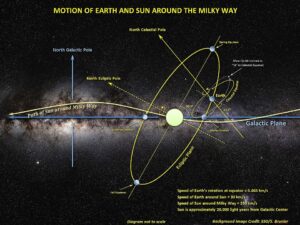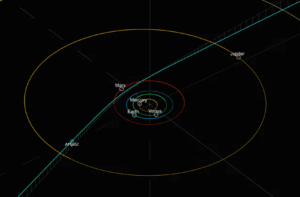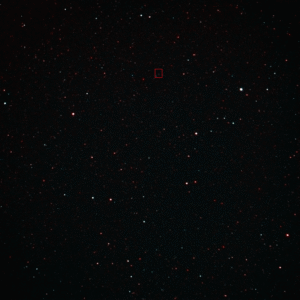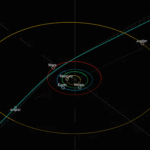WHAT IS 3i/ATLAS???
We have all heard and seen all these supposed images of the interstellar object known as 3i/ATLAS… In some images (all created by AI and borrowed from the Star Trek tv series ) claims are being made that these are the ‘latest released images’ and so forth. Time to cut through all the false garbage that people create for clicks. This article is the DEFINITIVE statement of understanding that we have about 3i/ATLAS. First, the most powerful telescope our civilization has ever made is in orbit 1 million miles away from earth at a LaGrange point (like a parking spot in space) and has imaged 3i/ATLAS… Here are those images attached to this article below.
Notice it doesn’t look like some “alien spaceship.” Notice it doesn’t look like the Planet Killer from the Star Trek episode “The Doomsday Machine”. No… It STILL looks like a blob with NO detail AS EXPECTED for a small object. So, what is it? Let’s explore shall we?
What’s its size?
With the latest information it now appears to be larger than we thought… Then again, its an interstellar comet coming in along the plane of our solar system. Current estimates are fuzzy due to the outgassing of materials blocking any visible nucleus. We know its could be larger than Oumuamua and comet Borisov, the only two previous interstellar objects. It can be as small as 0.2 miles in size BUT as large as 28.5 miles in size…. So, you see, it’s NOT EASY to tell the size of an object that is surrounded by a cloud of outgassing gas and dust… once it gets a little closer, we can make a better estimate. Current estimates put it closer to the upper limit on the hypothetical size. This larger than expected size could be for a variety of reasons not the least of which is that it came from our galactic disk, an area known for its dusty and icy regions which could, over billions of years, allow a comet to acquire more material and grow to large size.
What’s its path?
One thing to understand is that the Solar System is inclined to our galactic plane by about 60-62 degrees… This means that the Sun is roughly centered on our galactic disk, and orbits that galaxy with the planet plane at this 60+ degree angle. Thus, any object coming into our Solar System can come in from the galactic disk considering the orientation how the plane of the galaxy passes right through our Solar System. The illustration shows this arrangement.

What’s it made of?
Looking at its light spectra, we can identify different molecules and atoms in the ‘coma’ which is the dust and gas that is hiding the nucleus itself from us. The object has a very high abundance of Carbon Dioxide (CO2), some water ice, water vapor and Carbon Monoxide (CO). Finally, there is also some Carbonyl Sulfide (COS) a carbon atom with an oxygen and a sulfur atom which looks similar to Carbon Dioxide molecule where one oxygen is replaced by a sulfur atom). Latest results show that Cyanogen is also present which is a Carbon and Nitrogen atom bonded together with a second pair of the same atoms. So, its C2N2. This compound along with carbon produces a green glow which we now see. It is also sporting a small tail. NONE of this is unexpected for a comet and ALL of it is unexpected for a SPACECRAFT. There is perhaps a nucleus made of similar components and chemistry plus a rocky core like we see with many comets.
What’s its age?
It’s very, very old. This object entered the Solar System and came from the Milky Way’s thick disk of stars, gas and dust. This means it might be at least 7 BILLION years old. The Sun is 4.6 billion years old for comparison. So, this object could be 1.5 times the age of our Solar System.
What’s its speed?
The speed is how we know that it is interstellar… if this object came from far beyond the cloud of icy cometary objects known as the Oort Cloud, then it would have a speed that is faster than any Oort Cloud object could achieve by falling into the Inner Solar System. And this is what we see. It’s moving at 137 thousand miles per hour, (approx. 61 km/sec) much faster than an object falling in from the far out Oort cloud could achieve.
What is its trajectory?
because it is coming in along the galactic thick disk, it is coming it is somewhat aligned to the plane of our solar system This means that it stands a chance of passing some of our planets. Right now, Mars (already passed), Venus, and Jupiter, are the three planets that it will swing by as it passes through and then continues on out of the solar system and back into interstellar space. Its fast speed means that it is not going to be gravitationally bound to the Sun. Planets move in roughly circular orbits around the sun and there are other objects that move in elliptical orbits around the sun. This object is on a trajectory that will take it in and out of our solar system and it’s called a “hyperbolic” trajectory.

What will be its closest approach to the planets?
Mars
Mars saw this object at its closest point on October 3, 2025 so just a few days before this writing. In fact, Mars is the FIRST planet in our Solar System to see this subject in a “close approach”. That distance was actually 18 million miles.
Venus
Venus will see this object at its closest point to the planet on November 3, 2025. When it passes Venus, it will be 60 million miles from the planet.
Earth
The closest this object will ever get will be about 170 million miles or just shy of the distance to Mars. 3i/ATLAS will only approach to about 130 million miles of the sun which is 1.4 astronomical units. This closest approach will be on December 19, 2025.
Jupiter
In its final approach, 3i/ATLAS will pass its closest to the Jovian giant on March 16 2026.
No planet, including Earth, will be seeing this object “close” so do not believe the internet garbage intended to get clicks. So, there you have it! The truth about 3i/ATLAS. No baloney, no sensationalism, and most importantly no fake pictures to confuse and try to take control of a narrative for clicks. Enjoy the ACTUAL images of the interstellar visitor. Below are images of 3i/ATLAS. The one with the small red box is one we took with our SkyTour LiveStream Benson Arizona telescope system. The other is the James Webb image.


Find us here: www.youtube.com/@STLS and at www.skytourlive.org




